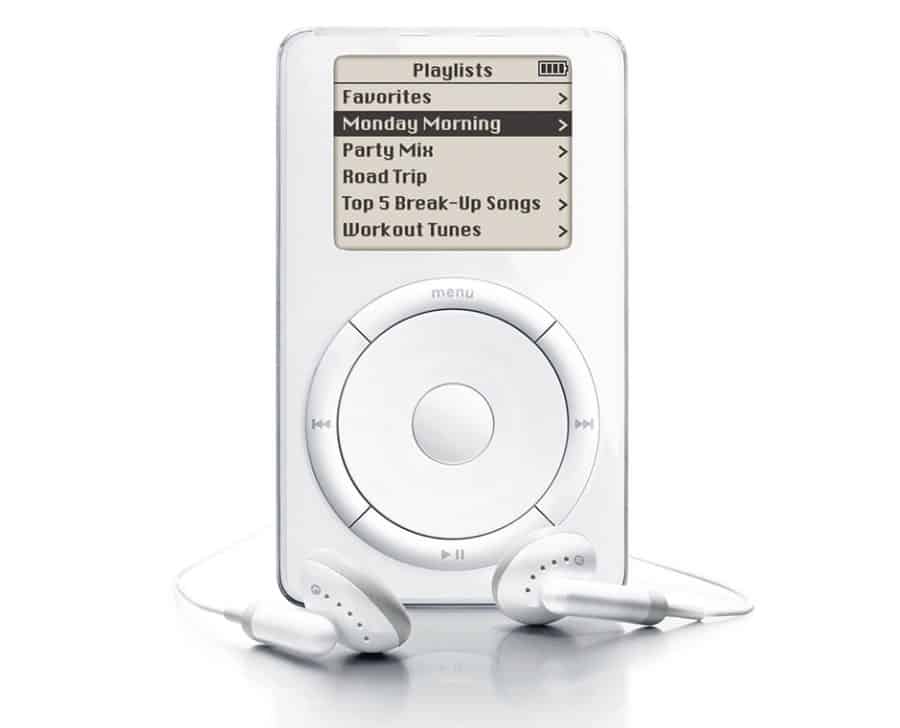
Above: Apple’s first iPod. Photo courtesy Apple.
BitDepth#1229 for December 26, 2019
Into every life must come, one day, an item of technology that makes a difference, that changes your perspective on what’s possible.
The iPod.
I only ever owned one iPod. The second version of the device, a hefty hunk of polished metal and plastic around the size of a half-pack of cigarettes.
It’s embarrassing to think of it as something to walk around with today.
When you can put a 256GB memory card into a smartphone, a device with 5GB of storage sounds silly.
But that iPod, even with its technical limitations and clumsy interface fundamentally changed the way I thought about the programming I listened to while on the move.
I started with recordings of radio shows and that led me to the next big change.

Audible
Soon after he introduced the iPod, Steve Jobs announced a landmark collaboration with an online vendor of recorded books, Audible.
Getting a book onto the iPod was a complicated and unwieldy process. You downloaded a file from the company’s website then transferred it to the iPod with iTunes, but once you were done, you had a library of recorded books on the digital player, without the pile of boxed CDs that was normally part of the audiobook experience.
I hooked up to my car stereo with a cassette adapter, and it’s true to say that 600 books later, I haven’t disconnected it since.
The connection has changed, the device has changed and Audible now has an excellent app, but the appeal of the central concept has only been burnished to a brilliant finish with time.
It’s probably helped that Amazon saw the synergies with their business and bought the company in 2008. Audible is believed to be the single largest employer of actors in the New York area.

Adobe Photoshop 1.07
In late 1989, I saw my first copy of Adobe Photoshop in action. It had just been bought by Adobe, renamed from its original title, Barneyscan and was, by modern standards, a primitive image editor.
But the first time I saw a scratch removed using the clone tool, I knew the old ways were over. What had been a laborious job involving a light table, special dyes, a fine brush and either keen eyesight or a magnifying glass was now a few clicks with a modifier key. To say that I was sold would be an understatement.
I have enormous and pervasive issues with Adobe as a company these days, and I have been auditioning replacement image editors, but CS6, the last version you can license in perpetuity, remains a go-to tool for my work.

The Palm III
There was a time that I used, in ordered rotation, a Palm III PDA, an iPod and a mobile phone. This was before the mobile device got fed Internet spinach and beat the stuffing out of the other two.
More than either device, though, the Palm III presaged a future, not all that distant, in which you could work on a computer in the, well, palm of your hand.
I raised eyebrows by tapping away at it in meetings, everyone else sure that I was playing a game, not taking notes, bought a keyboard for it to write at greater length and read PDB formatted books for it. I’ll be honest; I miss the puny underpowered thing.

The Titanium PowerBook
Officially, Apple’s pro 15 inch laptop, it was the first laptop I’d owned that was powerful enough to be a desktop replacement and not a satellite computer.
When the household management set eyes on it for the first time, she dubbed it Gwyneth after its pale, slinky good looks.
That laptop was the point at which my work shifted to portable devices with more powerful desktop system reserved for heavy lifting and archival storage.

Minolta’s Dimage 7
My embrace of digital photography was a slow, extended process. First, I stopped making prints and scanned directly from processed film.
Then I started mixing in images from prosumer point and shoot digital cameras. The Minolta Dimage 7 was my third digital P&S, and it shaped everything about how I work with images today. It was with that camera with its puny sensor that I truly confronted the difference in possibility that separated camera baked JPEGs and RAW files.
The Dimage 7 also brought me face to face with the space and post-production demands of RAW images. To open the files in Photoshop directly I had to use a third-party plug-in from a programmer in the Czech Republic.
It was a mess. It was the future.

The Global Village 56k Modem
Global Village created exactly the right product for exactly the right time, producing the best possible hardware to control two different and soon to be obsolete communications mediums.
Their modems used excellent hardware for dial-up connections and bundled in a peerless software package for sending faxes using the same phone line.
For a while, it was perfection. Reliable dial-up connection and excellent design and file management tools for faxing was a nexus of convenience and elegance.
Then, broadband.


